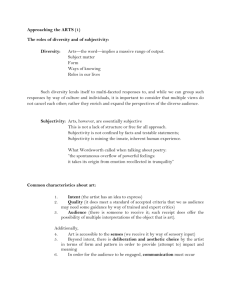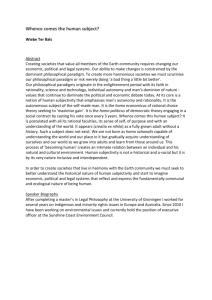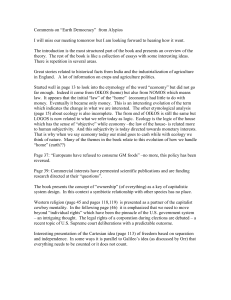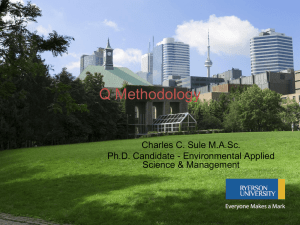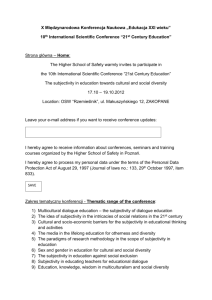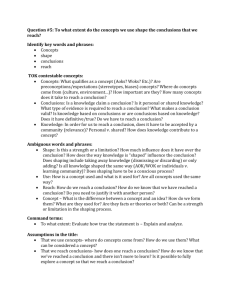The Child and Symbol:
advertisement
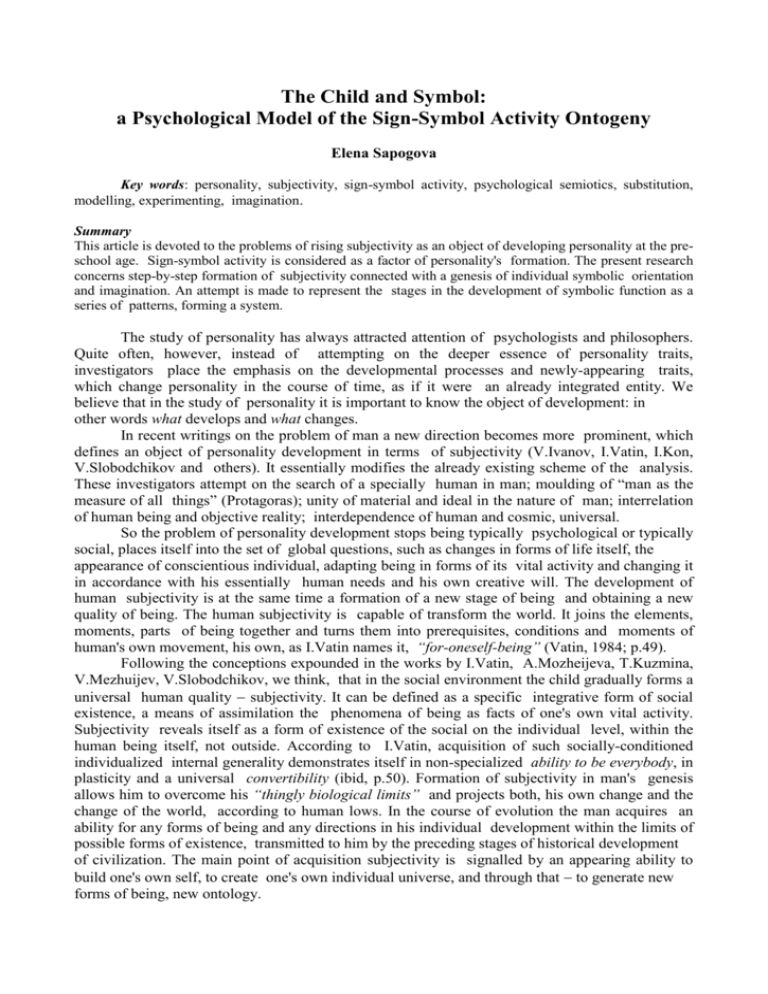
The Child and Symbol:
a Psychological Model of the Sign-Symbol Activity Ontogeny
Elena Sapogova
Key words: personality, subjectivity, sign-symbol activity, psychological semiotics, substitution,
modelling, experimenting, imagination.
Summary
This article is devoted to the problems of rising subjectivity as an object of developing personality at the preschool age. Sign-symbol activity is considered as a factor of personality's formation. The present research
concerns step-by-step formation of subjectivity connected with a genesis of individual symbolic orientation
and imagination. An attempt is made to represent the stages in the development of symbolic function as a
series of patterns, forming a system.
The study of personality has always attracted attention of psychologists and philosophers.
Quite often, however, instead of attempting on the deeper essence of personality traits,
investigators place the emphasis on the developmental processes and newly-appearing traits,
which change personality in the course of time, as if it were an already integrated entity. We
believe that in the study of personality it is important to know the object of development: in
other words what develops and what changes.
In recent writings on the problem of man a new direction becomes more prominent, which
defines an object of personality development in terms of subjectivity (V.Ivanov, I.Vatin, I.Kon,
V.Slobodchikov and others). It essentially modifies the already existing scheme of the analysis.
These investigators attempt on the search of a specially human in man; moulding of “man as the
measure of all things” (Protagoras); unity of material and ideal in the nature of man; interrelation
of human being and objective reality; interdependence of human and cosmic, universal.
So the problem of personality development stops being typically psychological or typically
social, places itself into the set of global questions, such as changes in forms of life itself, the
appearance of conscientious individual, adapting being in forms of its vital activity and changing it
in accordance with his essentially human needs and his own creative will. The development of
human subjectivity is at the same time a formation of a new stage of being and obtaining a new
quality of being. The human subjectivity is capable of transform the world. It joins the elements,
moments, parts of being together and turns them into prerequisites, conditions and moments of
human's own movement, his own, as I.Vatin names it, “for-oneself-being” (Vatin, 1984; p.49).
Following the conceptions expounded in the works by I.Vatin, A.Mozheijeva, T.Kuzmina,
V.Mezhuijev, V.Slobodchikov, we think, that in the social environment the child gradually forms a
universal human quality subjectivity. It can be defined as a specific integrative form of social
existence, a means of assimilation the phenomena of being as facts of one's own vital activity.
Subjectivity reveals itself as a form of existence of the social on the individual level, within the
human being itself, not outside. According to I.Vatin, acquisition of such socially-conditioned
individualized internal generality demonstrates itself in non-specialized ability to be everybody, in
plasticity and a universal convertibility (ibid, p.50). Formation of subjectivity in man's genesis
allows him to overcome his “thingly biological limits” and projects both, his own change and the
change of the world, according to human lows. In the course of evolution the man acquires an
ability for any forms of being and any directions in his individual development within the limits of
possible forms of existence, transmitted to him by the preceding stages of historical development
of civilization. The main point of acquisition subjectivity is signalled by an appearing ability to
build one's own self, to create one's own individual universe, and through that to generate new
forms of being, new ontology.
Subjectivity is caused by a deep change in the human vital activity with the appearance of a
possibility to turn one's vital activity into an object of practical transformation, when an individual
comes to be the subject of his own transforming activity. It is only in human being that it becomes
possible to treat oneself as the object of desired changes and at the same time as the subject,
actively directing and putting these transformations into effect. This, by itself, is an act of creation.
It, in a way, (though not absolutely) “withdraws” the subject from the hard determinism of the
objective reality and forms the basis of human liberty. May be that is why many researches faced a
necessity to look for connections, links between arising subjectivity and creative processes,
imagination, fancy.
In his latest works V.Davydov treats as “personality only a subject, possessing a certain
creative potential” (Davydov, 1988; p.23). Such traits of personality as creativity, plasticity,
freedom of convertibility and others are becoming, according to many studies, generic traits of any
human being. Their absence erodes the very nature of human in man.
Sharing all these conceptions, we shall attempt in this article to analyse the complex
interrelations, existing between the processes of subjectivity's genesis in human being and the
development of imagination, creativity. To understand it better is possible with the help of
analysis individual symbolism orientation, sign-symbol activity through which a child familiarizes
himself with the social being, with the world of things and people.
We are influenced in our position here by P.Florensky. He wrote: “All my life I thought
practically about one thing: about the relation of phenomenon to nomenon, about detecting of
nomenon in phenomena, revealing it and the forms of which it is actually embodied about the
symbol''(Florensky, 1990; p.13). Following P.Florensky we consider this point one of the central
in understanding the essence of human in man.
We suggest that sign-symbol activity should be understood as a complex, systematic,
multi-level, hierarchically organized entity. It enables an individual to model objective reality, to
transform it in his consciousness, to structure it into idealized objects and operate them with
the help of numerous signs and symbols. Let us now trace the interrelations existing between
individual symbolism orientation, subjectivity (as the central constituent of personality) and
imagination, creativity.
Though it may be important, subjectivity arises not as interiorization of objects and their
functions. Not even through interiorization of their social treatment resulting from a condensed
experience of humanity. It first of all reveals itself through various sign systems in a direct contact
with other people, through relations with already fully-fledged subjects carriers of such
experience. According to V.Slobodchikov, “in the process of growing up various forms of human
co-occurrence come into being, diverse personal abilities appear. They enable him to draw into
various human communities with their forms of culture and leave them by self-individualizing and
starting to create new forms, that is to become distinctive” (Slobodchikov, 1991; p.43).
The child is born to a certain cultural historic level of existing sociality, consciousness and
forms of activity. Other individuals are for him not only an environment for individual
development of his personality (which coexist together with many other conditions). They
constitute an ontological basis for the appearance of human subjectivity, the basis for normal
development and completeness of human life (Slobodchicov, 1986; p.17). Being indissolubly tied
with the grown-up, the child forms with him a certain space of co-occurrence. By it his
specifically human abilities are developed the “functional organs” of subjectivity. Later they let
the child treat his own vital activity reflexively. Co-occurrence, in Slobodchikov's opinion, that is
an object of personality development. It is that which changes, is being changed, and the results in
the appearance of a certain form of subjectivity. In the ontogeny the forms of co-occurrence
become complicated, differentiated, improve, remaining both the same and different because of a
contradiction in two internal processes self-opposition and self-identification.
In the course of self-opposition of the child in the initial form of co-occurrence a
transformation of connections into relations takes place. This is an indispensable condition of
developing subjectivity.
In the course of identification with the grown-up in co-occurrence the child gets acquainted
with the cultural experience of humanity by restructuring the connections and generating new
ones. The two opposite processes (self-opposition and self-identification) become a live
contradiction of the co-occurrence. “Through this double relation to man an individual and man
as genus the child's crib becomes “the cradle of socialization”, and the baby lying in it ``starts to
consider himself as a human being”. That is the child starts forming its internal world as an
individual world of a human being'' (Vatin, 1984; p.61). So a child becomes an individual
inevitably and necessarily, because a grown-up personality stands nearly.
Acting in a psychological space of co-occurrence, the child within the capacity of his vital
functions extracts the essence and interiorizes special objects other people.
Human languages, sign systems, symbols carry an instrumental function in condition of the
arising child's subjectivity. Like usual tools and instruments used by man to give the form to
materials of the outward reality, sign systems are used to mould subjectivity into something
discrete out of unsteady, unstable, polysemantic continuity of human life. According to K.Marx,
subjectivity is a reflected synthesis of the possible forms of human existence in the world. That is
why it originates in activity in realization of practical man-to-man relations, relations to the
society, world, history, and in the final analysis, to himself.
The appearance of subjectivity in the context of sign-symbol activity may be associated, in
our opinion, with several significant moments: breaking off the function (quality, property) from
an object-carrier; turning it from a sign of another into the sign for oneself; absorption of material
existence by the functional one; acquisition of material status by the functional existence;
acquisition of its own objective value by the functional existence; a double determination of the
independent functional existence by concrete and wider systems of “circulation”. In other words,
separated from other individuals qualities and properties are withdrawn beyond the limits of their
direct carriers. They become in a certain way opposed to man, that is form a specific sign reality.
Subjective existence of this sign reality absorbs its material existence in the process of penetrating
into its essence. According to I.Vatin “subjectivity seems to be torn from its objective basis,
becomes “thesign of itself”, acquires an independent objectively socialized value. It becomes
self-sufficient in relation to itself” (Vatin, 1984; p.47).
The appearance of subjectivity renders a new quality to the whole existence, sets a human
measurement to it. Possessing subjectivity man can elevate above any form of his vital functions.
Making himself an object of his own transformation, the man acquires a universal flexible ability
to become anything, to adapt to any forms of existence, created by the preceding generations. He
becomes the measure of all things.
The mother's subjectivity becomes the first specific object to be interiorized for the child.
The latter assimilates, recreates his mother's subjectivity, reproduces it in the forms of his own
actions and then returns to the grown-up. Restructuring the forms of the adult's activity into the
ways of his own existence, the child seems to offer the grown-up a model of interaction to serve
them both. The grown-up collates it, “catches” up, reproduces it in his own terms and again
``holds'' it as a model for the child to acquire it. In this way the process of reciprocal double
imitation is carried out, in which there appear the forms of behaviour, non-identical, nonisomorphic. We deal here with material exteriorization of the
objectivized media of
communication in such acts as echolalia in its various forms and symbolic actions as mimicking
and poses.
Thus, between the child and the adult there exists from the very start a specific sign
community, a kind of mutual sign association, which makes mutual understanding possible and
allows to develop it further. It's interesting that the child's and the adult's sign systems overlap
only in part and function for this particular child and grown-up in a co-existence given act of cooccurrence. Only later, step by step the child acquires the code, which is used by the grown-up,
until that he acts, not quite realizing himself an acting individual. For example, crying to make his
mother return into a room, the child fulfils (though unconsciously) his semiotic function to be a
sign for other people. The grown-up tends to personify his child's cry, interpreting the child's
subjectivity and his “self-entity” (where it does not exist yet!). In accordance with the human
experience he ascribes a certain meaning to a child's cry.
With the appearance of the first social reactions the semantic system of co-existence
restructures: the infant is turning into an “addressee” who is personally addressed. The “personsituation” (M.Lisina) form of communication develops. The walking and talking stage indicates
new developments in subjectivity. Walking which frees the infant's hands sets him into a fourdimensional space, where he finds an acting adult and begins him own acting. We observe the
onset of infant's activity by which he discloses the qualities and functions of objects. Speech
“liberates the child from his immersion into his co-existence and facilitates his
ability to comprehend his own “self” (Slobodchikov, 1986; p.20). With the help of the word --- a
universal sign subjectivity turns into its own object. Formed at 3, the child's “functional organs”
of subjectivity are commented and assessed by the adult in the process of upbringing. So out of a
great variety of actions the child reinforces a set of those “typically encouraged” actions which
constitute the contents of his self-awareness. As V.Slobodchikov writes, both the child's speech
and acts are adult-oriented. They create and consolidate multiple points of identification, points of
self-identification and self-authenticity. A certain \emp{``animation''} of child's vital activity takes
place (ibid, p.21).
In communication the child develops first instrumental and quasi-instrumental (connected
with play, symbolic) actions. The former include the child into the co-operation with the adult. The
latter include the child into those forms adult's activity which are not accessible for the child
practically, though possible in play and in symbols. Secondly, the child comes to know material
things as a result of discovering their qualities and functions. He also becomes able to act in quasiobjective situations (speech, cognition, etc.), created by the child himself. These allow the child to
act in the plane of ideal entities. The forms of activity, familiar to the child since preschool age
(new forms of address, role and symbolic games, creative activity), stimulate a further
development of subjectivity as a complete system. Comparing himself and his actions with
“standard” forms of behaviour, the child modifies his self-vision and learns to control himself.
Thus, it is quite possible that already at his pre-school age, when subjectivity initiates, the
child participates in 3~group of semiotic relations: (1) a grown-up or any other man as a sign for
the child to decode actively; (2) the child himself as a sign for anybody else; (3) the child as a
sign for himself. The latter we connect not only with self-awareness, but also with revealing of
one's own opportunities and their exteriorization in the results of creative activity. Developing and
studying oneself as a sign, revealing one's own qualities and functions for other people, turning
oneself into a product of one's own activity, the human being strengthens himself, lengthens his
existence, consolidates his subjectivity through creative acts of various kinds. The essence of
personality development lies in the growing subjectivity. Subjectivity penetrates into the
existence, spreads itself all over; individuals extrapolate it on the world of things and people. As
F.Barron writes, “creative work is a general condition for the human's development, his rising
complexity, originality, his unique dissimilation and difference from others” (Barron,1990; p.154).
In general opinion the processes of growing subjectivity are first found in the child of 3,
when the child starts getting his own activity's subject and can consider himself an object of his
operating. The possibility of being a sign both for oneself and others, in our opinion, is directly
connected with the development of imagination and other forms of sign-symbol activity.
Let us prove this thesis. In the “child-adult co-existence”, as we have already mentioned,
there appears a certain sign space, which contains specific sign information to be grasped and
learnt, in the process of actualization of the sign reality. At every step of the child's personality
development the sign-symbol activity takes different forms. We presume, that the first phase is
connected with acquiring of sign systems as means, tools of specifically human nature. Here we
can refer to L.Vygotsky who mentioned the role of signs in the internal psychic processes and the
necessity to learn them at an early age. P. Florensky distinguished between material tools
(machines, instruments) and ideal tools of an interior plan (concept and symbols). The second
phase begins with the use of the obtained means in the construction of models and their further
utilization for extracting information about objects and phenomena of the outward reality. The
third phase is connected with some creative acts. It allows the man himself to create both
material things and sign systems, to operate the models, again extracting absolutely new
information and thus creating the new ontology. We called these 3 phases substitution, modelling
and mental experimenting respectively.
It is possible to distinguish several steps in developing the sign-symbol orientation in the
pre-school child. Each of the steps will be marked by new traits of a wider, more universal order
than the sign-symbol function, and go out far beyond it.
At the zero stage there is practically no independent sign-symbol function to consider. The
child tries to assimilate the sign-symbol means to realize his initial relations with the adult in
their joint activity. Only later that these means will fulfil the function of substitution. According to
G.Glotova, “the semiotic activity of any level is directed on the formation of a specialized
language, some reflecting substratum, by which later new signs will be expressed. The signs
reflected and expressed will on the one hand result in the changes and development of the
substratum. On the other hand these new signs will be correlated with developing forms of activity.
In fact, development is always like this: we acquire a new specialized language, than with
its help we learn something new again” (Glotova, 1990; p.125--126).
The form of such specific original language is imitation. By it the child responses to the
adult's behaviour: a voice to a voice, a smile to a smile. It isn't a formal copying the adult's
actions, of his “language”, but a performing in the child's own forms of activity the ways and
means of the child-adult contact. Later they become symbols, signs, “words” of their cooccurrence. It is with their help that mutual understanding between the child and the adult is set.
Imitation “doubles” any existing form, makes it different, but the same in function, because
as it realizes the doubled form on some other material, in some other bodily appearance. The
doubled contents of the co-occurrence is “inter-individual”: it cannot be used by either of them
separately, as it loses it sense, completely or partly. If a child is short of contacts with other people,
his development is retarded: he has no initial word-keys to start reflecting reality on the human
level.
Gradually this integrated non-differentiated imitation begins to break. This happens under
the influence of specialized adult's acts directed on the child. Cry, shout and other sounds,
expressing biological needs of the child, turn into listening and understanding the adult's speech
addressed to him. Later infantile babbling appears and repetitions of sound combinations, than
prattling, “prattle speech”. Of course, the significance of these forms of speech is limited. In adult
speech the words and things events are not clearly correlated. By 8-9 months the child begins using
his vocal experimenting to attract and hold adult's attention. Let's note, that an initial function
“adulta sign for the child” begins to actualize another function “the child a sign for the adult”.
At the same period of time the vocal mimicry, if encouraged, develops into the first attempts of
nominalization.
In the development of the object decoding activity at the zero stage we observe first nonspecific movements. Later, by the end of the first year first manipulations with simple objects
appear. Later still coping the actions with objects shown by the grown-up in their standard form.
This moment is of great value, though these actions are poor in content and manipulations are
numerous. For the grown-up objects possess some constant fixed meaning. The child should
extract this meaning. However hard the child would try to carry out an action with an object, it
won't reveal its essence. The child needs to be taught, that is why the adult would show the actions
with things, disclosing the meanings of human objects to the child. In this way the child is drawn
into the previous experience of humanity.
The peculiarity of the zero stage is in the fact, that the child's own actions with the things
are poorly connected with their objective content, lying outside them. The child, co-existing in the
same sign system with the grown-up, does not as yet use these signs for their proper purpose. The
child is unable to understand the qualities and functions of the objects.
By the end of the zero stage (after the first year of life) an important contradiction appears.
It is the necessity to associate signs, existing in one outer form, with some other, hidden in their
material form, objective content (speech sounds with their meanings, etc). This presupposes quite
natural passage beyond the limits of the original form of co-occurrence and beyond the concrete
actions with objects only in agreement with their “hingly” nature. Active talking with the use of
poly-functional substitutes is observed. The child learns to express his thoughts and emotional
experience in their standard (accepted by the society at the given period) sign system or at least
approaching it. For the activity with objects this is a transfer of acquired actions into a wider class
of actions. With the play coming into being, it gives new possibilities to use certain objects in the
function of some others and to assume roles. The zero-stage is also the time when drawing
develops after scribbles.
The first stage (1-3,6 years) is the time for acquisition and mastering (finishing touches!) of
various sign systems. The sign systems (the language of music, of motions, speech, drawing, etc)
are brought to some average level. At this stage of sign-symbol orientation development the child
does not create or change anything in obtained sign systems and in the environment (the level of
reproduction). In a certain sense, he remains rather a “consumer”. We presume that the child is
now at the stage of acquisition and testing of substitution, without yet reflecting his substitutes and
actions with them. The child learns sign-symbol reality as a special object, without as yet making
it an instrument of his own cognitive activity or its change. Nevertheless, at an early age already
this is a need to build a plan, ti outline a scheme of actions, forms of expression thoughts, etc. The
necessity to treat sign systems actively as method of reflecting reality arises. In other words, a
contradiction is growing between the level at which the signs are obtained and new tasks, new
aims and interests to be solved with their help.
All this is closely connected with the appearance of the initial forms of imagination. The sign
systems at one's disposal form the basis for constructing various patterns of objects, schemes of
actions, etc. That is the new form in which the sign-symbol orientation passes to the second stage
- the stage of modelling.
It's necessary to stress, that the way of developing the sign-symbol orientation lies not only
through the widening and differentiation of interiorized sign systems, but rather through a change
of the child's treatment of them. The child modifies his actions with the signs, treating them as
tools, not as new opposing sign-symbol objectivity to be studied anew. At each stage the child's
activity, his independent treatment of sign-tools grows. He uses them comprehendingly; his power
in operating them enlarges to a considerable extent.
The substitution stage enables the child to translate real phenomena and objects of reality
into various sign-symbol languages. The modelling reveal the essential properties of things and
phenomena, is further used as a method of cognition, as a method of obtaining information
about substituted objects, as a method of building the world conception. With them the child
recreate an idealized objectivity to be operated and used. In this idealized objectivity everything
the child knows and understands, takes its definite systemic place, conditioned by the logical and
associative connections. In fact, at this stage the child passes from learning sign-symbol systems to
their “exploiting” at his will, to get new cognitive “profit”. So sign-symbol systems turn
from a goal to a means, serving the child's needs.
In speech this results in a possibility to express a certain content (of thoughts, feelings, emotions)
in a flexible, exact way. The child acquires a skill to put questions, to formulate a problem
(“hypothesis”). He is now able to create verses (though with a share of naive “plagiarism”'!); to
coin words; to guess the riddles; to grasp humour, metaphors, proverbs and sayings; to understand
contexts. A development from manipulative play to role-play takes place, where quite expressed
functional substitution is observed. Children begin to acknowledge the rules and orient to them. In
their first attempts to modelling they assume roles and act according to the rules. Children's
graphic activity is characterized by a change from schematic drawing patterns to the appearance of
plot drawings, expressing children's emotions, feelings, moods, individual original images. They
also attempt to render some artistic ideas, plans, plots. The same is found
in constructing, in models in clay in applique work and other forms of children's activity. An
imprint of the child's personality, his individuality, his “self” may be clearly seen.
Play fulfils an exclusively important function in child's rising subjectivity. In fact, as soon as at the
age of 2 the child begins to play, one can observe that all subjective traits, though fragmentary and
elementary, are present. D.Elkonin, considering the role of pre-school play, writes that in play “the
child learns meanings of objects, orienting to their social function”, which is, before anything,
connected with involvement of object-substitutes into play (Elkonin, 1978; p.168). The same was
also marked by J.Piaget, who thought symbolic play to be the peculiarity of the pre-school age and
a variety of sign-symbolic activity of the child. The idea of substitution lies in the fact, “that one
object is created from another. The former remains real only in the child's imagination, within the
frame of the play, in an ideal form. In other words, the child enters the play, when he is capable of
creating, though on the primitive, elementary level” (Vatin, 1984; p.57).
Modelling is the stage which appears at the pre-school age (4-5), continues at school and in adult
age, especially if required by one's professional activity. This is the stage of the most significant
transformation in sign-symbol activity of an individual. He learns to build adequate, complete,
integral models of reality in accordance with his own notions of it, with his individual experience
in cognition and communication. The child acquires the function of building idealized quasireality, which, being transformed, brings him some new information about reality. Operating his
models, creating them, the child can “catch” something new in them (a facet, connection,
property, quality). It is this, that in our opinion, makes it possible for him to develop qualitatively
new level of sign-symbol orientationmental experimenting.
The sign-symbol activity develops at its any step both as internal and external. At the stage of
modelling external line is represented by constructing, modelling in clay, play, drawing, etc. The
internal line finds its expression in one's ability to plan something and release one's plan, keeping
in mind the result to be obtained. All this requires imagination. And it develops as an important
new trait of the pre-school age together with thinking, growing arbitrariness of the
psychic processes and other qualitative changes in the child's personality and activity.
Imagination develops as a universal human ability to see that, which really exists in the world, to
see the diversity of things, their qualities and properties. It is due to imagination that common
experience of humanity is correlated with separate facts of individual experience. Thanks to it the
things , which are not acquired by abstract-logic thinking may be achieved by the power of
imagination. An isolated fact may be unfolded in the internal plane of imagination to make visible
its general, universal character. This is the position, advanced by E.Ilyenkov (1960) and followed
by V.Davydov (1992).
Imagination has numerous functions. One of them is interpreted as a power to generate new
entities (images, thoughts and further, on their basis, objects and actions). Imagination
restructures and transforms “the old”, which exist in reality, by finding some essential, earlier not
observed, facts, links, relations.
The images, imagination operates, are flexible, dynamic, fluctuating, divergent, possess a certain
modus of changeability. That is why an individual can “gather and scatter” properties of his
images in accordance with his heuristic creative will. The mechanism of imagination in general is
described by V.Davydov in the following way: one of the properties of an object is torn away from
it and passed onto another image which in principle does not possess it. If the transferred property
is significant for the image, a new image is created. And if, led by the creative image, an individual
is able to embody it into a real object, a new thing appears. If the image cannot be realized as a
material object, it remains a fantastic (as chimeras, centaurs).
The development of sign-symbol activity to the stage of modelling enables an individual to single
out essential properties of one object and substitute the latter by another. This substitute starts to
fulfil the functions of the original object in the individual's activity. It turns into a sign-symbol, as
it embodies the properties of the original object. So the symbols are the carriers of the universal
(the essential) of real things. As E.Ilyenkov puts it, “functional existence of a symbol is in its role
as a means, tool of revealing the essence of other sensually percepted things, that is their
Universal” (Ilyenkov, 1984; p.178).
Signs and symbols allow to construct models “abstractions of a certain kind, in which
essential relations of objects are expressed in percepted and visualized connections and relations of
sign components, a unity of the universal and the isolated (that is the abstract and concrete) in
which the universal and essential is front-lined” (Davydov, 1992; p.24). All these considerations
allow to describe imagination in terms of modelling. So it proves that imagination is closely
connected with sign-symbol activity.
Imagination helps an individual to act not only according to traditional schemes, but also going
beyond their limits, heuristically. The power of operating the models, of creating new model
systems, of working out means of their creation, etc leads sign-symbol function to its third stage,
which we called a stage of mental experimenting. The individual is now capable of the
anticipating reflection and creative acts. It is but natural, that in childhood we can speak only about
pre-conditions of mental experimenting and its elements. Nevertheless, the sign-symbol
orientation seems to initiate as a whole system in childhood, however uneven the development of
its parts may be. For instance, by the senior pre-school age, the system may be allegorically
represented as “yesterday-today-tomorrow”. Substitution is “yesterday” of the sign-symbol
function, without which “today” (modelling), containing “tomorrow” (mental experimenting), is
impossible.
At the stage of mental experimenting an individual obtains a wide freedom of operating the
models, which he can transform in any imaginable directions. He can also analyze his models in
their various structural connections, turning them away in his imagination from any logical
regularities. The signs, symbols, models cognitive tools transform into heuristic instruments,
by which this individual achieves feedback coercion on the environment, imposing his subjective,
human logics, his human measure, and finding in this way the innermost connections in the world
around.
Transferring properties of one image on another, the child's consciousness restructures the latter,
makes it heterogeneous. This causes the search of new homogeneity. For this aim the singled-out
property is given the status of a systemic one, “structure-generating”, able to organize the new
entity out of the “old” parts in accordance with new systematizing trait. “Grasping” and keeping in
one's consciousness the new entity, fitting the “destructured” systems to it, forms the basis of
creative actions.
With developed sign-symbol orientation, imagination, thinking in its structure, creativity allows to
extend oneself in the world, to reinforce and lengthen one's power. Anticipating reflection provides
an integral, all-round cognition of the world and as E.Ilyenkov thought, allows to see the world
“with the eyes of all other people” (Ilyenkov, 1964; p.60). The latter seems to be a pre-requisite of
specifically human consciousness. So imagination may be considered an important constituent
part of the personality genesis. No consciousness is possible without imagination. “Imagination
itself “organizes” perception (that is sensuality). Altogether they form
the basis of creative activity of an individual, generate his personality” (Davydov, 1992; p.26).
This is supported by numerous investigations, which prove that since 3 the child can act
independently: to pass “from a plan to putting it into life; from thought to a situation not from a
situation to a thought” (Elkonin, 1989; p.150). In fact, by the end of early childhood, the forms of
child-adult co-occurrence disintegrate, and the child starts to separate himself and his actions from
the grown-up and his actions. The child displays his own wishes and a tendency to independence
(“the crisis of 3-year-olds”). Since this time the grown-up will be present in his role-playing only
indirectly. It is of importance, that at the pre-school age. The child is involved into artistic activity,
he learns to draw, to model, construct independently, begins to experiment with objects,
subjugating their “thingness” to his subjectivity and in this way satisfying his heuristic needs. All
these are forms of activity in which the child trains and masters his independence, his
individuality, his subjectivity. According to V. Davydov, “the pre-school child forms a framework
of his personality development level. By the end of this age children may become individuals,
possessing personality” (Davydov, 1992; p.29).
P.Florensky wrote at his time, that ``mental creativity divides into the production of things the
sense of which is not visual, and the production of meaning, reality of which is not obvious''
(Florensky, 1977; p.103). It may be supposed, that the production of new subjective entities is fact
the creative act of individual seeing, one's “subjective glance”, which reflects not only its direction,
but something which deals with him personally. Widening of one's influence on the world, setting
one's “self” in it, one's individuality that, in our opinion, is the highest personal realization of an
individual. In its primitive forms it is within the capacity of a pre-schooler, as an individual,
personality.
References
Barron F. A Personality as a Function of Designing the Man Himself (Russ.). In: Voprosy
psichologii, 1990. № 2.
Davydov V. Towards the Definition of Personality in the Contemporary Psychology (Russ.). In:
Psychological Journal,1988. № 4.
Davydov V. The Origin and the Development of Personality in a Pre-school Age (Russ.). In:
Voprosy psihologii, 1992. № 1-2.
Elkonin D. Psychology of Play (Russ.). Moscow, 1978.
Elkonin D. Selected Papers in Psychology (Russ.). Moscow, 1989.
Florensky P. From Theological Heritage (Russ.). In: Theological Papers. V.XVII. Moscow,
1977.
Florensky P. The Particular (Russ.). Moscow, 1990.
Glotova G. The Man and the Sign: Semiotic-Psychological Aspects of Human Ontogeny (Russ.).
Sverdlovsk, 1990.
Ilyenkov E. On Aesthetic Nature of Philosophy (Russ.). In: Voprosy estetici, 1964. № 6.
Ilyencov E. Dialectic Logics (Russ.). Moscow, 1984.
Slobodchikov V. Psychological Problems of Genesis of Human Internal World (Russ.). In:
Voprosy psihologii, 1986. № 6.
Slobodchikov V. The Category of Age in Psychology and Developmental Pedagogy (Russ.). In:
Voprosy psihologii, 1991. № 2.
Vatin I. Human Subjectivity (Russ.). Rostov-na-Donu, 1984.
